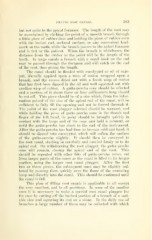Page 737 - My FlipBook
P. 737
FILLING KOOT CANALS. 383
but not quite to the apictil foramen. The length of the root may
be ascertained by sticking the point of a smooth broach through
a little piece of rubl)er dam and liolding tlic piece of rubber even
with the incisal end, occlusal surface, or any convenient land-
mark on the tooth, while the broach passes to the apical foramen
and is felt by the patient. Wlien the broach is withdrawn, the
distance from the rubber to the point will be the length of the
tooth. In large canals a broach with a small hook on the end
may be passed through the foramen and will catch on the end
of the root, thus giving the length.
The canal should be flooded with eucalyptol or oil of caju-
put, liberally applied upon a wisp of cotton wrapped upon a
broach, and the excess dried out with a fresh wisp of cotton
that has first been dipped in the oil and well squeezed out with
another wisp of cotton. A gutta-percha cone should be selected
and a portion of it about three or four millimeters long should
be cut off. This piece should be of a size which, from the infor-
mation gained of the size of the apical end of the canal, will be
sufficient to fully fill the opening and not be forced through it.
The point of the root plugger selected should be warmed, and
while holding the piece of gutta-percha cone in the thumli and
finger of the left hand, its point should be brought quickly in
contact with the large end of the cone and held a moment, or
until the gutta-percha has stuck to the end of the instrument.
After the gutta-percha has had time to become cold and hard, it
should be dipped into eucalyptol, which will soften the surface
of the gutta-percha slightly. Tt should then be conveyed to
the root canal, starting in carefully and carried firmly in to its
apical end. On withdrawing the root plugger, the gutta-percha
cone will remain, closing the apical end of the root. This
should be repeated with other bits of gutta-percha cones, cut
from larger parts of the cones as the canal is filled to its larger
portion, using the larger root canal plugger. After the first
two or three pieces, the subsequent ones may be slightly sof-
tened by passing them quickly over the flame of the annealing
lamp and directly into the canal. This should be continued until
the canal is full.
This plan of filling root canals is applicable to all except
the very smallest, and to all positions. In some of the smaller
ones it is necessary to make a special root canal plugger for
the case by cutting off the barbed portion of a broach of a suit-
able size and squaring its end on a stone. In the daily use of
broaches a large number of these may be collected with which


